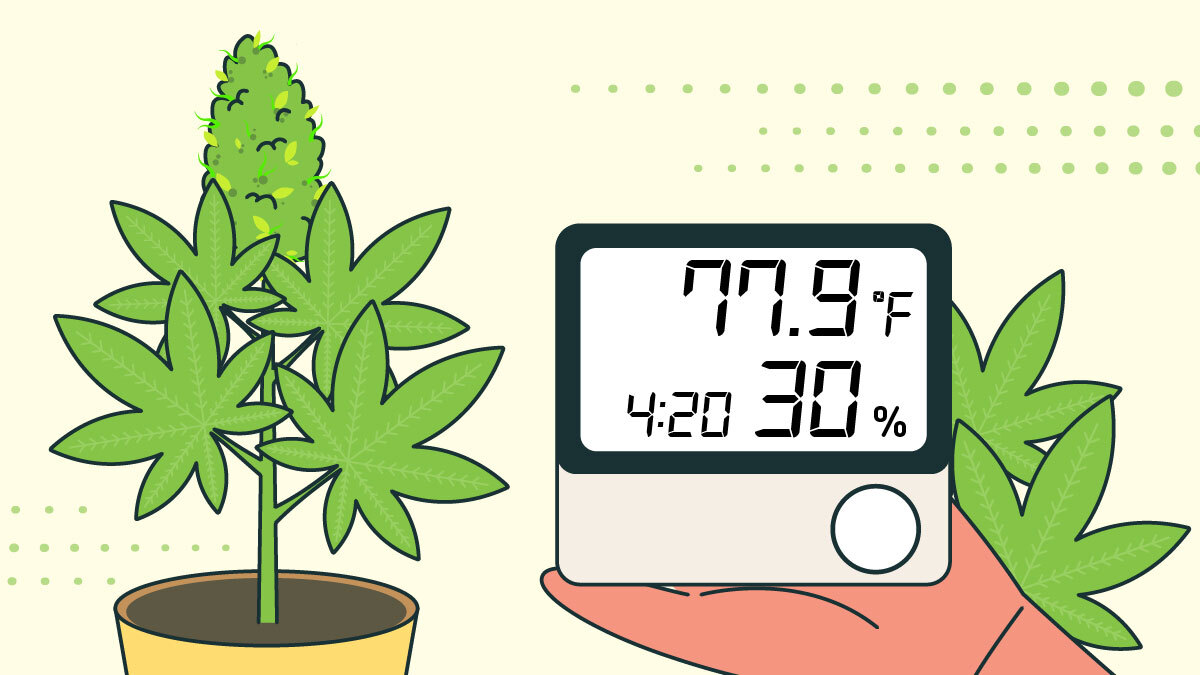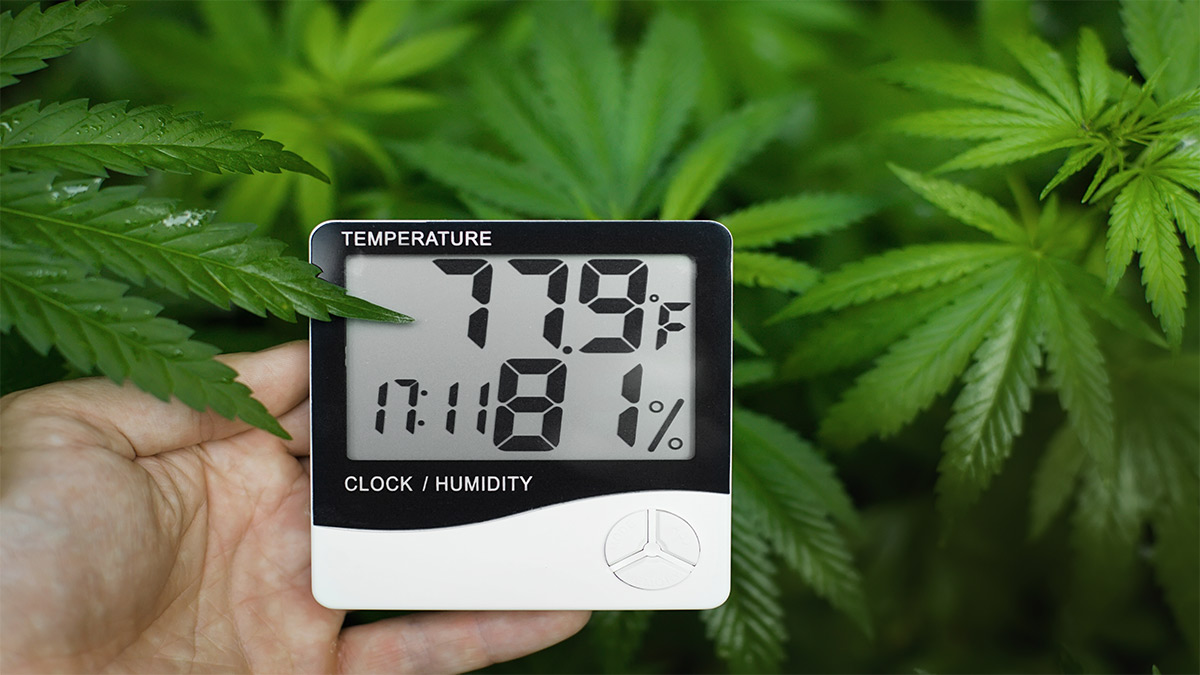What is the Best Humidity for Growing Weed Indoors?

Those who live in “legal” marijuana states, and decide to grow their own personal supply, may start by planting outdoors.
It’s an obvious choice for people who’ve had vegetable or herb gardens for years. In fact, it’s an understandable choice for anyone to make. Sticking a few pot plants in the ground doesn’t require lots of expensive equipment or finding indoor space to set it up. If the budding growers are fortunate enough to live in an environment conducive to cannabis cultivation, growing weed may not even require a lot of work.
Others aren’t that fortunate. They may live in a less-forgiving climate, they may have to deal with predators and regular insect infestations, or they may have to hide their grow from nosy neighbors.
They may also have already tried growing their supply outdoors with less-than-optimal results.
Setting up an indoor grow room is the next natural step. It can be complicated if the grower is ambitious, or it can be relatively easy if they just want to put a couple of plants in a closet.
No matter the size or scope of an indoor weed garden, though, most people will realize they need stands, pots, and a growing medium, grow lights, and perhaps a way to block ambient light.
But the one factor that most inexperienced growers don’t pay enough attention to is the humidity in their grow space. They should — because the humidity is one of the biggest factors that will determine whether they have a bountiful crop or an epic fail.
What Is Humidity?
We’ll start at the beginning. Most people know enough to tell when the outdoor weather is humid or dry, but they may not remember enough junior high school science to be able to discuss humidity in meaningful terms.
Don’t worry, this won’t be too complicated. “Humidity” simply describes the amount of water vapor that’s in the air. “High humidity” means the air’s water content is high, which is why you may feel wet and sticky when the weather is extremely humid. “Low humidity” means there’s little water in the air, which is why your throat may feel dry when the humidity falls (or if you’re in the desert).
“Relative humidity,” the term meteorologists use to describe humidity, is a way of comparing how much water is in the air to the maximum amount of water it can contain. When the relative humidity is 100%, the air contains as much water as it can possibly hold. If it’s 10%, the air contains almost no water at all. Warm air is able to hold more water than cold air, which is why “hot and humid” always seem to go together.
Why is that important when you’re growing weed? It’s not what you might think. In almost all stages of their growth, marijuana plants don’t get most of the water they need from the air. Instead, high humidity helps prevent the water they contain from evaporating into the air. However, high humidity also promotes the growth of mold and bacteria, and as the plants grow, it can become a big problem for other reasons.
Why Humidity Levels Are Important When Growing Marijuana
All flowering plants “like” to grow in certain humidities, largely based on their native climates.
Ferns, orchids, and other tropical plants thrive in hot and humid weather. Cacti, yucca, and rubber plants, on the other hand, don’t do well in humid conditions.
Cannabis is somewhat different.
It’s generally able to grow in humidity ranges between 40% and 70%. However, marijuana plants grow in an unusual way. Once they’ve entered the flowering stage, their dense buds grow so closely together that it’s difficult for air to flow between them.
Here’s why that’s a problem. As water evaporates from the plants’ leaves, the clusters of buds give it nowhere for it to go — creating small pockets of humid air between the buds. That’s an invitation for mold, mildew, and ruined flowers.
And that’s why monitoring and controlling humidity is so important when you grow weed plants. In their early stages, they flourish in relatively-humid air. In later stages, that same air can destroy the crop.
Beginning indoor growers should immediately invest in hygrometers, which measure the relative humidity of the air surrounding their plants. And they should do whatever’s necessary to adjust the humidity in their grow room as their plants move through their growth stages.
Ideal Humidity For Marijuana Plants

The perfect humidity levels for a cannabis plant will depend on its strain and where it was originally grown (or for hybrids, where its parent strains came from). Sativa and sativa-dominant strains are generally from warmer climates, so they prefer more humidity than indica or indica-dominant strains.
Most growers aren’t going to get quite that granular, though; they use general rules of thumb that will work for most strains. Here are the relative humidity levels that weed plants love.
A) Seedling Stage:
Plants that are being grown from seed prefer relative humidity between 65-70%. Clones like humidity even higher, as high as 80-85%. Humidity helps seedlings get extra water through their leaves, and encourages root development.
B) Vegetative Stage:
A relative humidity between 45% and 65% is best during this growth stage, and many experienced growers slowly lower the humidity by 5% every week or two. The plants are now getting almost all of their water through their roots.
C) Early Flowering Stage:
This is when the buds begin growing densely, and also when mold and mildew are most likely. As we’ve explained, that means humidity must be lowered. 40%-50% relative humidity is ideal in this stage, and it should never be allowed to climb above 60%.
D) Late Flowering Stage:
The humidity should be even lower when the plants are 1-2 weeks away from harvest. It should be no higher than 40%; if you can get it down to 30% that’s even better because that will help increase yields.
All of this sounds complicated. It is — unless you know how to control the humidity in a grow room.
Controlling Humidity When You Grow Marijuana
Maintaining optimal humidity levels during your grow will require a few adjustments and practice to get it right.
Fortunately, there are a number of steps you can take to increase or lower humidity during a grow:
Tips For Increasing Humidity
- Place humidifiers in the room. Be sure to monitor your hygrometers; the humidity can quickly get too high if you’re not careful.
- Place open containers of water around your plants, and keep the soil moist. You can also mist the plants and soil every few hours, as long as they’re not flowering yet. (If there are buds growing, this could cause rot.)
- Raise the temperature in the grow room. This won’t make a big difference, but it can help as long as the temperature doesn’t go so high that it interferes with the plants’ growth.
- Turn down the power on exhaust fans. That will keep more warm, moist air in the room.
Tips For Decreasing Humidity
- Set up dehumidifiers in the grow room. You’ll probably need them when the plants approach harvest.
- Only water your plants at the start of the “growing day,” once you’ve turned on the lights.
- Boost the power on exhaust fans to remove warm and moist air.
Your choice of humidifiers/dehumidifiers may be just as important as choosing the right grow lights for your setup. They should be large enough (or you should use enough of them) to take care of the entire grow room.
One of the biggest mistakes that new growers make is paying all of their attention to light and temperature, and forgetting about humidity. Thankfully, you’re now knowledgeable enough so you won’t make that mistake.
The Best Humidity For Growing Marijuana: FAQ
Q: Is there anything you can do to control humidity for outdoor grows?
A: There are certainly fewer options. However, protecting plants from excess heat will usually help, as will watering at night to prevent quick evaporation. In the late flowering stage, removing morning dew from leaves can help as well.
Q: Are there better strains to grow in a hot, humid climate?
A: Yes. Look for sativas; strains like Skywalker Haze and Amnesia Haze flourish in high humidity. If you’re growing in a dry climate, Afghan Kush and Sour Diesel (even though the latter is sativa-dominant) are good choices.
Q: What about once you’ve harvested your flower?
A: You have to dry and cure it before it’s ready to enjoy, and the conditions still matter during those processes. Humidity should be kept at 45%-55%, with lots of ventilation and moderate temperatures, until the weed is fully cured.